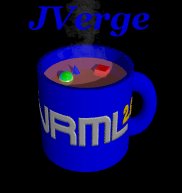

vlc.vrml.external.geometry For use with applets
vlc.vrml.internal.geometry For use with VRML scripts
vlc.vrml.generic.geometry For use with standalone applications
vlc.vrml.VrmlTypes defines the various type IDs that are used
by all of the classes. Each interface package also includes a file called
VrmlRoot.java which are examples on how to build a node that
represents the root of the scenegraph. It also shows how you could derive
the classes within JVerge to provide your own custom node.
VrmlObject.
All classes are derived from this. It outlines some of the basic fucntionality
that is required of all nodes. Here you will find variables that indicate the
type of the node, a reference to the appropriate Java Node which contains
the actual node representation after the call to createVrmlFromString().
The other interesting thing to note is the static Browser
reference that is there for the internal and external packages. This is so that
you only need to set the browser reference once at the very start and then
you can create the nodes without needing to cart around Browser references
all through your application code.
There are then three main methods that are used:
The first is cleanup. Cleanup looks after the internal cleaning up,
any reference counting and stuff like that. It should be called just before you
remove any reference to this node when you are creating a subclass of VrmlObject.
In normal day to day use of the classes there is no need for you to use this
method at all. If your derived class contains MF/SFNodes then it should
recursively call the cleanup methods of those nodes as well.
The second method is called writeReset. This is should be called
immediately before starting to write this node to a file. Like cleanup, it is
recursive and looks after any children nodes that might exist.
The final method is the abstract method writeToStream which takes
two arguments. The first is a PrintStream and the second is the level of indent.
For most applications this should start at zero and then let JVerge take care
of the indenting internally.
For all the classes there is a default constructor supplied. This will create
an instance of the node that is completely default as per the VRML 97 spec. For
nodes where you want to supply non-defualt values for any field type
fields then another constructor is provided for that. In the case where you have
a number of different browsers there is also variants on the above two methods that
include a Browser reference as the first argument. The other constructors
use the static reference that is contained within the class.
import vlc.vrml.external.geometry.*;
public class myApplet extends applet
{
Browser browser;
public void start()
{
Browser = Browser.getBrowser(this);
// etc
}
{
// in a method somewhere deep in the code....
Transform tx = new Transform(Browser);
// then you need to add this to some
// pre-existing node in the scene.
some_SFNode_eventIn.setValue(tx.node);
}
}
Note the use of the node reference from the Transform class when adding it into the scene.
set_browser method.
The previous example now becomes:
import vlc.vrml.external.geometry.*;
public class myApplet extends applet
{
Browser browser;
public void start()
{
browser = Browser.getBrowser(this);
VrmlObject.set_browser(browser);
// etc
}
// in a method somewhere deep in the code....
{
Transform tx = new Transform();
// then you need to add this to some
// pre-existing node in the scene.
some_SFNode_eventIn.setValue(tx.node);
}
}
After the first call in the start method to set the browser reference there is no
need to carry it anymore.
I recommend this approach is the better to use if you are going to be creating a lot of nodes. I would only use the former when I was running an applet that was talking to two or more browsers at the same time where the two Browser references will be different, depending on which one you are creating geometry for.
appearance
value of an Appearance node there is a set_appearance method. The following
example creates a red box with dimensions of x = 2, y = 3, z = 4.
import vlc.vrml.external.geometry.*;
public class myApplet extends applet
{
Browser browser;
public void start()
{
browser = Browser.getBrowser(this);
VrmlObject.set_browser(browser);
// etc
}
// in a method somewhere deep in the code....
{
float[] color = {1, 0, 0};
Shape shape = new Shape();
Box box = new Box(2, 3, 4);
Appearance app = new Appearance();
Material mat = new Material();
// set the material to red
mat.set_diffuseColor(color)
// now combine them all together
shape.set_geometry(box);
shape.set_appearance(app);
app.set_material(mat);
// then you need to add this to some pre-existing node in the scene.
}
JVerge is deliberately very lax about where it writes the data to. So long as a PrintStream is provided then that is all that is needed. Just open a stream connected to a socket or a file and off you go. The following code is taken from VermelGen that writes the output to a String.
import java.io.*;
import vlc.vrml.external.geometry.*;
public class VrmlScene
{
private Browser browser;
private VrmlRoot file_root;
// lots of snipped code!
public String getSceneDescription()
{
ByteArrayOutputStream os = new ByteArrayOutputStream();
PrintStream ps = new PrintStream(os);
file_root.writeToStream(ps);
String output = os.toString();
try
{
ps.close();
os.close();
}
catch(IOException e)
{
System.out.println("Error closing output streams");
}
return(output);
}
}
Now file_root uses the following code:
import java.io.*;
import java.util.*;
import vlc.vrml.external.geometry.*;
public class VrmlRoot extends GroupingNode
{
// lots of code snipped from here
public void writeToStream(PrintStream fp)
{
Enumeration e = _children.elements();
// firstly we need to reset the contents of the file
for(; e.hasMoreElements();)
((VrmlObject)(e.nextElement())).writeReset();
fp.println("#VRML V2.0 utf8");
fp.println("#");
fp.println("# Generated by the VermelGen http://www.vlc.com.au/VermelGen/");
fp.println("# GNU Software by The Virtual Light Company");
fp.println("# Released under the GPL ftp://ftp.sunsite.edu/pub/GNU/copyinfo.txt");
fp.println("");
e = _children.elements();
for(; e.hasMoreElements();)
((VrmlObject)(e.nextElement())).writeToStream(fp, 0);
}
}
From this you can see that you need firstly to open up a PrintStream of your
choice (this could be System.out if you wanted) and then call the writeReset
method so that the automatic DEF/USE system works correctly.